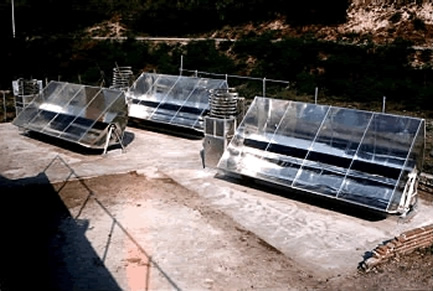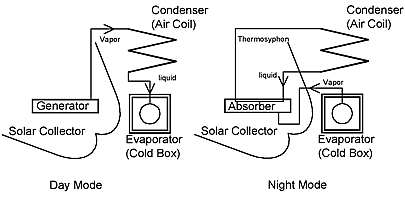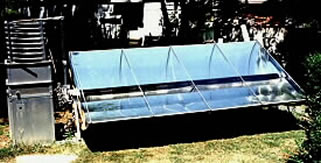- Home
- About Us
- Absorption Process
- Applications
- Publications, Technical Papers, News Releases
- Patent Estate
- Case Studies
- Energy Links
- Contact Us
(410) 266-6521
Get Our News
Sign up below to subscribe to our news
ISAAC Solar Ice Maker
 The ISAAC Solar Icemaker operates in two modes. During the day, solar energy is used to generate liquid ammonia refrigerant. During the night, the generator is cooled by a thermosyphon and ice is formed in the evaporator compartment as ammonia is reabsorbed to the generator.
The ISAAC Solar Icemaker operates in two modes. During the day, solar energy is used to generate liquid ammonia refrigerant. During the night, the generator is cooled by a thermosyphon and ice is formed in the evaporator compartment as ammonia is reabsorbed to the generator.
The ISAAC Solar Icemaker is an Intermittent Solar Ammonia-water Absorption Cycle. The ISAAC uses a parabolic trough solar collector and a compact and efficient design to produce ice with no fuel or electric input, and with no moving parts.
The daily ice production of the ISAAC is about 5 kg per square meter of collector, per sunny day. The construction of the ISAAC Solar Icemaker involves only welding, piping and sheet metal work, and there are no expensive materials. It is estimated that, when produced in-country where wages are low and transportation costs can be minimized, the 11 square meter ISAAC can be produced for less than $7,000. When produced in-country, the creation of urban employment is an additional advantage of ISAAC technology.
Key FeaturesThe characteristics of the ISAAC which make it particularly well suited to provide refrigeration to unelectrified rural communities are:
The ISAAC design was developed by Energy Concepts Company. Over forty systems have been built and twenty installed in seven countries. The ISAAC is on display in Annapolis, Maryland and at Sandia National Lab, Albuquerque, New Mexico. ISAAC is now being distributed and commercialized by Solar Ice Co.
Providing Jobs to Remote Communities – By Providing IceThe ISAAC Solar Icemaker makes enough ice at low cost to support many small scale businesses in rural unelectrified areas. Enterprises using ISAAC will be environmentally sustainable because no fuel is required. They will be economically sustainable because the cost of producing the ice by the ISAAC is sufficiently less than the value of the ice that it can easily be recovered by a micro-enterprise. Ice is of major economic importance. In rural communities of developing countries, there is frequently a shortage of ice to support business activities. The result is loss of revenue, jobs, and substantial food spoilage. Three important community needs for electricity are:
Lights, communication and entertainment require modest amounts of electricity and are affordable even at the high cost of electricity from emergency generators, diesel mini-grids or photovoltaics. When refrigeration is needed also, the amount of electricity required from the power system increases drastically. Thus it is usually omitted to keep costs down. An ISAAC Solar Icemaker supplies refrigeration without the intermediary step of electricity and at a much lower cost. Thus ISAAC Solar Icemakers, in combination with mini-grids and/or photovoltaics, are a good method of supplying remote community needs.
© Copyright 2000 - 2016 Energy Concepts Co. LLC. All Rights Reserved. |


 For example, ISAAC can provide domestic refrigeration. An ISAAC produces six blocks of ice each day, weighing ten kilograms each. If an icebox requires five kilograms of ice per day to stay cool, then one ISAAC will be able to supply domestic refrigeration to twelve households. The cost of a standard electric refrigerator, plus the constant requirement of expensive electricity, would be much higher.
For example, ISAAC can provide domestic refrigeration. An ISAAC produces six blocks of ice each day, weighing ten kilograms each. If an icebox requires five kilograms of ice per day to stay cool, then one ISAAC will be able to supply domestic refrigeration to twelve households. The cost of a standard electric refrigerator, plus the constant requirement of expensive electricity, would be much higher.